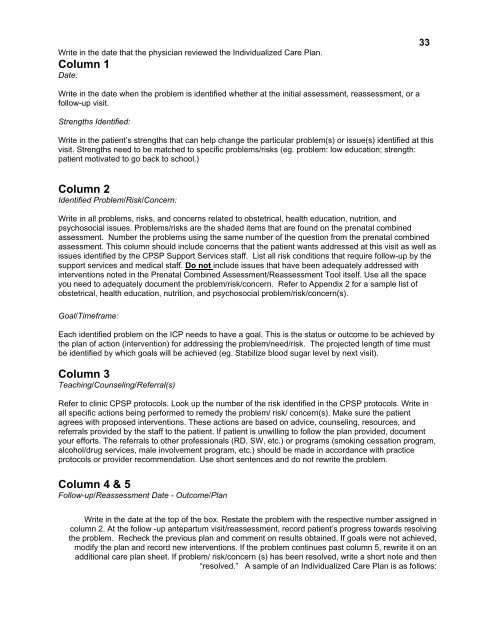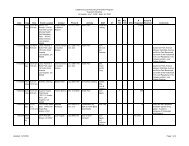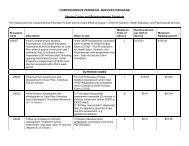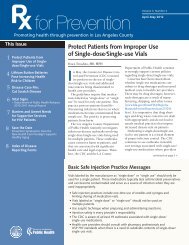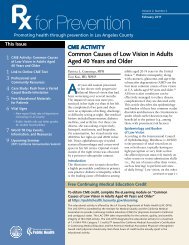Initial Combined Assessment (ICA) - Department of Public Health
Initial Combined Assessment (ICA) - Department of Public Health
Initial Combined Assessment (ICA) - Department of Public Health
Create successful ePaper yourself
Turn your PDF publications into a flip-book with our unique Google optimized e-Paper software.
Write in the date that the physician reviewed the Individualized Care Plan.Column 1Date:33Write in the date when the problem is identified whether at the initial assessment, reassessment, or afollow-up visit.Strengths Identified:Write in the patient’s strengths that can help change the particular problem(s) or issue(s) identified at thisvisit. Strengths need to be matched to specific problems/risks (eg. problem: low education; strength:patient motivated to go back to school.)Column 2Identified Problem/Risk/Concern:Write in all problems, risks, and concerns related to obstetrical, health education, nutrition, andpsychosocial issues. Problems/risks are the shaded items that are found on the prenatal combinedassessment. Number the problems using the same number <strong>of</strong> the question from the prenatal combinedassessment. This column should include concerns that the patient wants addressed at this visit as well asissues identified by the CPSP Support Services staff. List all risk conditions that require follow-up by thesupport services and medical staff. Do not include issues that have been adequately addressed withinterventions noted in the Prenatal <strong>Combined</strong> <strong>Assessment</strong>/Reassessment Tool itself. Use all the spaceyou need to adequately document the problem/risk/concern. Refer to Appendix 2 for a sample list <strong>of</strong>obstetrical, health education, nutrition, and psychosocial problem/risk/concern(s).Goal/Timeframe:Each identified problem on the ICP needs to have a goal. This is the status or outcome to be achieved bythe plan <strong>of</strong> action (intervention) for addressing the problem/need/risk. The projected length <strong>of</strong> time mustbe identified by which goals will be achieved (eg. Stabilize blood sugar level by next visit).Column 3Teaching/Counseling/Referral(s)Refer to clinic CPSP protocols. Look up the number <strong>of</strong> the risk identified in the CPSP protocols. Write inall specific actions being performed to remedy the problem/ risk/ concern(s). Make sure the patientagrees with proposed interventions. These actions are based on advice, counseling, resources, andreferrals provided by the staff to the patient. If patient is unwilling to follow the plan provided, documentyour efforts. The referrals to other pr<strong>of</strong>essionals (RD, SW, etc.) or programs (smoking cessation program,alcohol/drug services, male involvement program, etc.) should be made in accordance with practiceprotocols or provider recommendation. Use short sentences and do not rewrite the problem.Column 4 & 5Follow-up/Reassessment Date - Outcome/PlanWrite in the date at the top <strong>of</strong> the box. Restate the problem with the respective number assigned incolumn 2. At the follow -up antepartum visit/reassessment, record patient’s progress towards resolvingthe problem. Recheck the previous plan and comment on results obtained. If goals were not achieved,modify the plan and record new interventions. If the problem continues past column 5, rewrite it on anadditional care plan sheet. If problem/ risk/concern (s) has been resolved, write a short note and then“resolved.” A sample <strong>of</strong> an Individualized Care Plan is as follows:


